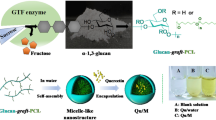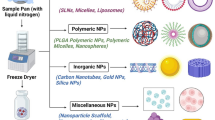Abstract
Anionic polymer sodium carboxymethylcellulose (CELLOGEN® HP-HS and/or HP-12HS) was investigated for its ability to influence the release of three model drugs propranolol hydrochloride, theophylline and ibuprofen from polyethylene oxide (POLYOX™ WSR 1105 and/or Coagulant) hydrophilic matrices. For anionic ibuprofen and non-ionic theophylline, no unusual/unexpected release profiles were obtained from tablets containing a mixture of two polymers. However, for cationic propranolol HCl, a combination of polyethylene oxide (PEO) with sodium carboxymethylcellulose (NaCMC) produced a significantly slower drug release compared to the matrices with single polymers. The potential use of this synergistic interaction can be a design of new extended release pharmaceutical dosage forms with a more prolonged release (beyond 12 h) using lower polymer amount, which could be particularly beneficial for freely water-soluble drugs, preferably for once daily oral administration. In order to explain changes in the obtained drug release profiles, Fourier transform infrared absorption spectroscopy was performed. A possible explanation for the more prolonged propranolol HCl release from matrices based on both PEO and NaCMC may be due to a chemical bond (i.e. ionic/electrostatic intermolecular interaction) between amine group of the cationic drug and carboxyl group of the anionic polymer, leading to a formation of a new type/form of the active (i.e. salt) with sustained release pattern.






Similar content being viewed by others
References
Vazquez MJ, Perez-Marcos B, Gomez-Amoza JL, Martinez-Pacheco R, Souto C, Concheiro A. Influence of technological variables on release of drug from hydrophilic matrices. Drug Dev Ind Pharm. 1992;20:2519–26.
Juarez H, Rico G, Villafuerte L. Influence of admixed carboxymethylcellulose on release of 4-aminopyridine from hydroxypropyl methylcellulose matrix tablets. Int J Pharm. 2001;216:115–25.
Li H, Hardy RJ, Gu X. Effect of drug solubility on polymer hydration and drug dissolution from polyethylene oxide (PEO) matrix tablets. AAPS PharmSciTech. 2008;9:437–43.
Tiwari SB, Rajabi-Siahboomi AR. Extended-release oral drug delivery technologies: monolithic matrix systems, from methods in molecular biology, Chapter 11. In: Jain KK, editor. Drug delivery systems, 437. Totowa: Humana; 2008. p. 217–43.
Moore JW, Flanner HH. Mathematical comparison of curves with an emphasis on in-vitro dissolution profiles. Pharm Tech. 1996;20:64–74.
Velasco MW, Ford JL, Rowe P, Rajabi-Siahboomi AR. Influence of drug: hydroxypropylmethylcellulose ratio, drug and polymer particle size and compression force on the release of diclofenac sodium from HPMC tablets. J Contr Rel. 1999;57:75–85.
Choi SU, Lee J, Choi YW. Development of a directly compressible poly(ethylene oxide) matrix for the sustained-release of dihydrocodeine bitartrate. Drug Dev Ind Pharm. 2003;29:1045–52.
Levina M, Rajabi-Siahboomi AR. The influence of excipients on drug release from hydroxypropyl methylcellulose matrices. J Pharm Sci. 2004;93:2746–54.
Levina M, Gothoskar A, Rajabi-Siahboomi AR. Application of a modelling system in the formulation of extended release hydrophilic matrices. Pharm Tech Eur. 2006;18:20–6.
Palmer D, Levina M, Rajabi-Siahboomi AR. The influence of in vitro dissolution method on the release of a highly water soluble drug from polyethylene oxide and hypromellose hydrophilic extended release matrices. AAPS annual meeting and exposition. 2008; Atlanta, USA
Guru GS, Prasad P, Shivakumar HR, Rai SK. Miscibility studies of polysaccharide xanthan gum/PVP blend. J Polym Environ. 2010;18:135–40.
Cid E, Mella F, Lucchini L, Carcamo M, Monasterio J. Plasma concentrations and bioavailability of propranolol by oral, rectal and intravenous administration in man. Biopharm Drug Dispos. 1986;7:559–66.
Taylan B, Capan Y, Guven O, Kes S, Hincall AA. Design and evaluation of sustained release and buccal adhesive propranolol hydrochloride tablets. J Control Release. 1996;37:11–20.
Serlin MJ, Orme ML, Maciver M, Green GJ, Sibeon RG, Beckenridge AM. The pharmacodynamics and pharmacokinetics of conventional and long acting propranolol in patients with moderate hypertension. Brit J Clin Pharmacol. 1983;15:519–27.
Ebube NK, Jones AB. Sustained release of acetaminophen from heterogeneous mixture of two hydrophilic non-ionic cellulose ether polymers. Int J Pharm. 2004;272:19–27.
Çaykara T, Demirci S. Preparation and characterization of blend films of poly(vinyl alcohol) and sodium alginate. J Macromol Sci. 2006;43:1113–21.
Conti S, Maggi L, Segale L, Ochoa Machiste E, Conte U, Grenier P, et al. Matrices containing Na CMC and HPMC. 1. Dissolution performance characterization. Int J Pharm. 2007;333:136–42.
Basavaraju KC, Damappa T, Rai SK. Miscibility studies of hydroxypropyl methyl cellulose and poly(ethylene oxide) by viscometry, ultrasonic, and refractometric methods. J Macromol Sci. 2008;47:417–25.
Rakkappan C, Anbalagan S. Ultrasonic and FTIR studies on aqueous biodegradable polymer blend solutions. Am Eurasia J Sci Res. 2009;4:281–4.
Feely LC, Davis SS. The influence of polymeric excipients on drug release from hydroxypropylmethylcellulose matrices. In J Pharm. 1988;44:131–9.
Nokhodchi A, Norouzi-Sani S, Siahi-Shadbad MR, Lotfipoor F, Saeedi M. The effect of various surfactants on the release rate of propranolol hydrochloride from hydroxypropylmethylcellulose (HPMC)-Eudragit matrices. Eur J Pharm Biopharm. 2002;54:349–56.
Baveja SK, Ranga Rao KV, Padmaltha Devi K. Zero-order release hydrophilic matrix tablets of β-adrenergic blockers. Int J Pharm. 1987;39:39–45.
Takka S. Propranolol hydrochloride–anionic polymer binding interaction. II Farmaco. 2003;58:1051–6.
Baveja SK, Ranga Rao KV, Singh A, Gombar VK. Release characteristics of some bronchodilators from compressed hydrophilic polymeric matrices and their correlation with molecular geometry. Int J Pharm. 1988;41:55–62.
Baveja SK, Ranga Rao KV, Padmaltha Devi K. Relationship between gum content and half-life of soluble β-blockers from hydrophilic matrix tablets. Int J Pharm. 1988;47:133–9.
Ranga Rao KV, Padmalatha Devi K, Buri P. Influence of molecular size and water solubility of the solute on its release from swelling and erosion controlled polymeric matrices. J Control Release. 1990;12:133–41.
Lu JW, Zhu YL, Gu ZX, Hu P, Yu J. Electrospinning of sodium alginate with poly(ethylene oxide). Polymer. 2006;47:8026–31.
Basavaraju TM, Rai SK. Miscibility studies of polysaccharide xanthan gum and PEO (polyethylene oxide) in dilute solution. Carbohyd Polym. 2007;69:462–6.
Raviprakash SD, Rai KS. Miscibility studies of sodium alginate/poly(vinyl glycol) blend in water by viscosity, ultrasonic and refractive index methods. Int J Plast Tech. 2004;8:334.
Mu X, Tobyn MJ, Staniforth JN. Influence of physiological variables on the in-vitro drug-release behaviour of a polysaccharide matrix controlled release system. Drug Dev Ind Pharm. 2003;29:19–29.
Reynolds TD, Mitchell SA, Balwinski KM. Investigation of the effect of tablet surface area/volume on drug release from hydroxypropyl methylcellulose controlled-release matrix tablets. Drug Dev Ind Pharm. 2002;28:457–66.
Colombo P, Catellani PL, Peppas NA, et al. Swelling characteristics of hydrophilic matrices for controlled release: new dimensionless number to describe the swelling and release behavior. Int J Pharm. 1992;88:99–109.
Reynolds TD, Mitchell SA, Balwinski KM. Investigation of the effect of tablet surface area/volume on drug release from hydroxypropylmethylcellulose controlled-release matrix tablets. Drug Dev Ind Pharm. 2004;28(4):457–66.
Gibaldi M, Feldman S. Establishment of sink conditions in dissolution rate determinations—theoretical considerations and applications to non-disintegrating dosage forms. J Pharm Sci. 1967;56:1238–42.
Korsemeyer RW, Peppas NA. Macromolecular and modelling aspects of swelling-controlled systems. In: Mansdorf SZ, Roseman TJ, editors. Controlled release delivery systems. New York: Marcel Dekker; 1983. p. 77.
Siepmann J, Kranz H, Bodmeier R, Peppas NA. HPMC-matrices for controlled drug delivery: a new model combining diffusion, swelling, and dissolution mechanisms and predicting the release kinetics. Pharm Res. 1999;16:1748–56.
Ritger PL, Peppas NA. A simple equation for description of solute release. I. Fickian and non-Fickian release from non-swellable devices in the form of slabs, spheres, cylinders or discs. J Cont Rel. 1987;5:23–36.
Ford JL, Mitchell K, Rowe PH, Armstrong DJ, Elliott PNC, Rostron C, et al. Mathematical modelling of drug release from HPMC matrices: effect of temperature. Int J Pharm. 1991;71:95–104.
Efentakis M, Koutlis A, Vlachou M. Development and evaluation of oral multiple-unit and single-unit hydrophilic controlled-release systems. AAPS PharmSciTech. 2000;1:1–9.
Khan KA. The concept of dissolution efficiency. J Pharm Pharmacol. 1975;27:48–9.
Higuchi T. Rate of release of medicaments from ointment bases containing drugs in suspensions. J Pharm Sci. 1961;50:874–5.
Higuchi T. Mechanism of sustained action medication. Theoretical analysis of rate release of solid drugs dispersed in solid matrices. J Pharm Sci. 1963;52:1145–9.
Timmin P, Delargy A, Minchom C, Howard J. Influence of some process variables on product properties for a hydrophilic matrix controlled release tablet. Eur J Pharm Biopharm. 1992;38:113–8.
Nockhodchi A, Ford JL, Rowe P, Rubinstein MH. The effects of compression rate and force on the compaction properties of different viscosity grades of hydroxypropyl methylcellulose 2208. Int J Pharm. 1996;129:21–31.
Liew CV, Chan LW, Ching AL, Heng PWS. Evaluation of sodium alginate as drug release modifier in matrix tablets. Int J Pharm. 2006;309:25–37.
Shah NH, Lazarus JH, Jarwoski CL. Carboxymethylcellulose: effect of degree of polymerization and substitution on tablet disintegration and dissolution. J Pharm Sci. 1981;70:611–3.
Hussain AS, Johnson RD, Shivanand P, Zoglio MA. Effects of blending a non-ionic and an anionic cellulose ether polymer on drug release from hydrophilic matrix capsules. Drug Dev Ind Pharm. 1994;20:2645–57.
Dabbagh MA, Ford JL, Rubinstein MH, Hogan JE, Rajabi-Siahboomi AR. Release for propranolol hydrochloride from matrix tablets containing sodium carboxymethylcellulose and hydropropylmethylcellulose. Pharm Dev Technol. 1999;4:313–24.
Oren PL, Seidler WMK. Sustained release matrix. 1990; US patent no. 4,968,508.
Rogers V, Dor PJM, Fix JA, Kojima H, Sako K. Soluble drug extended release system, 2004; United States patent, US 2004/0091518 A1, 1–14.
Takka S, Rajbhandari S, Sakr A. Effect of anionic polymers on the release of propranolol hydrochloride from matrix tablets. Eur J Pharm Biopharm. 2001;52:75–82.
Tucker IG, Ahmed GH, Stewart PJ. The binding of propranolol hydrochloride to sodium carboxymethylcellulose. Aust J Hosp Pharm. 1988;18:196–9.
Walker CV, Wells JI. Rheological synergism between ionic and non-ionic cellulose gums. Int J Pharm. 1982;11:309–22.
Sriwongjanya M, Bodmeier R. Effect of ion exchange resins on the drug release from matrix tablets. Euro J Pharm Biopharm. 1998;46:321–7.
Acknowledgements
The authors are grateful to Dai-Ichi Kogyo Seiyaku and IMCD for generous supply of Na CMC and ibuprofen, Charlotte Penny (Sekisui Diagnostics) for assistance in interpretation of potential chemical interaction and Colorcon for providing Ph.D. scholarship.
Author information
Authors and Affiliations
Corresponding author
Additional information
Guest Editors: Michael Repka, Joseph Reo, Linda Felton and Stephen Howard
Rights and permissions
About this article
Cite this article
Palmer, D., Levina, M., Nokhodchi, A. et al. The Influence of Sodium Carboxymethylcellulose on Drug Release from Polyethylene Oxide Extended Release Matrices. AAPS PharmSciTech 12, 862–871 (2011). https://doi.org/10.1208/s12249-011-9648-4
Received:
Accepted:
Published:
Issue Date:
DOI: https://doi.org/10.1208/s12249-011-9648-4




